Here it is! The answers to all of your questions. There was such a good mix submitted, so I’ve divided the questions up by category: those that pertain to work and design, living in New York and SF, my history with food and wine, and then all the good personal questions too. Have at it, thanks for all your questions, and feel free to ask any questions about the questions in the comments :)
Questions on Work + Design
Q: Creativity strikes in such random instances. Have you figured out a system/process of filing ideas away that works for keeping you sane?
A: Kinda sorta? My unofficial system is: leave yourself little breadcrumb trails of cool things that will allow you to rediscover said things at a later date, and be delighted by them all over again. For the record, I only designated this as my “system” once I started answering this question, went through all the places I house inspiration, and found like three things that made me go, “Oh, awesome, I forgot all about that!”
I have bookmarks folders in Chrome, where I’ll often save websites that have interesting design features or things I want to remember. These are organized by layout inspiration, font inspiration, and little details that I might love on a site. I have a folder in Gmail labeled “Resources,” in which I’ll file any emails that have links to good content I want to explore at a later date. I’ve kept my Pinterest boards pretty organized, so sometimes hopping in there is great to get the creative juices going. Lisa (my web developer) and I also keep running lists of interesting techniques to try on new web projects, so going through those links often helps me work through a design conundrum.
Finally, I spend a LOT of time surfing the Internet, and this inevitably leads me to cool retailer websites or digital publications that I end up sharing here, or bookmarking in one of the aforementioned spots!
So yeah, breadcrumbs. Oddly enough, this non-system really works for me, because I think by going to each of these places, I get inspired the same way I “naturally” would — simply by stumbling upon content (or in this case, things I’ve probably forgotten about), exploring, clicking around, and seeing what looks interesting that day.
They’re very specific to my work, but a few places I always love browsing are FontShop, Fonts In Use, and Codrops.
//
Q: Can you describe your design and development process? I’m trying to get into coding and would love to get a glimpse into what it’s like.
A: Coding, or the development process, is entirely different from the design process. By the time you are coding a website, you should know pretty much everything about what you want it to look like*. These design decisions are driven by the client/business needs, pain points you’re solving, business goals, and the overall brand identity you are trying to communicate, among other things. You can think of coding like building the house from the blueprints — it’s not really advisable to build the house without the plan in place first.
In the early stages, I work with clients to discuss many different aspects of their project: we talk about the identity (things like their logo, fonts, colors, their aesthetic, what they’re trying to communicate with the brand identity, who they’re trying to reach and resonate with), their existing website (what’s working, what isn’t), as well as some of their overall goals from a business perspective (are they trying to grow their YouTube channel, specifically? Are they trying to grow affiliate revenue? Do they need to showcase 10 years worth of projects in an interactive portfolio, in order to display the breadth of clients they’ve worked with?). This provides a lot of information for me, as the designer, to figure out how to build an identity and lay out a site. With a lot of this information, putting a website together can feel like putting pieces of a jigsaw puzzle together; you have all these pieces that you know have to fit, and you have a limited space to do it in. For me, that’s a ton of fun.
I tend to build out loose wireframes in Photoshop for web projects. This means using general shapes and text to plan out where things will go. Depending on the project, sometimes these are shared with the client for approval, without any of the extra details and frills. But often, once I establish this, I’ll then go ahead and apply a lot of the graphical elements, like fonts and colors, as well as placeholder content, so the client can see their own work within the new framework. The home page (or home pages) are presented first; we revise this, and from that, I build out all remaining templates for their site.
Once a project has been designed, I do a fair bit of work prepping files for web development. This is all done to make development easier for Lisa, or whichever developer I’m working with. My process includes grouping layers, organizing artboards by template and interactive effects (like hover, pop-up and scrolling effects), and creating specs for all aspects of a template — things like the number of pixels between two elements, or the dimensions of an image or a column or text, or writing out the properties for a how a page title is supposed to look, with CSS. I also extract fixed assets for a design (assets refer to things like a logo, background patterns, or other elements that aren’t going to be built with code — these are typically all images), and any placeholder imagery that the developer might need to upload in order to test the code (say, images for a slideshow). Everything is packaged up in Dropbox, then shipped off. Once the site’s coded, I review the test site using Chrome’s developer tools, to make any adjustments to the code so that it accurately reflects what was in my (and presumably the client’s) head. That’s pretty much it! It can be a long, detail-oriented process, but it’s a blast.
*One little caveat: I wrote above that when you code a website, you should know what it’s going to look like ahead of time. In some instances, this isn’t 100% true — I think for larger teams working together, building a prototype makes a ton of sense so that all invested parties can get their hands on the site and iterate on a living thing (prototyping tools like InVision are amazing for this). However, for my one-person studio, and given the clients I’m typically working with, it doesn’t make financial or calendar sense to work this way all the time. Hope that helps lift the veil on the process a bit!
2018 edit: About a year and a half ago, I started syncing all my Photoshop files to InVision for client presentations. That’s my standard method for presenting now! These days, InVision has a huge suite of products that makes the design to dev stage a lot faster and easier (I’d die without Craft Sync, Inspect, Data, and other plugins they create). I’ve also begun using Sketch instead of Photoshop specifically for web layouts, as this program works like a dream with InVision and is meant for designs of this nature.
//
Q: Were there any resources that were particularly helpful for you when learning CSS?
A: I got this exact question via email a long time ago, but I get similar inquiries regularly, so I decided to include it. To be honest, I taught myself over time, with making little changes to my blog and experimenting or Googling when I didn’t know how to do something. Check out W3 schools; they talk about every single CSS property (and lots more) and have tools you can use to kick the tires on the code and see how it affects a site.
If you have a website or blog currently, you can also use the Inspect Element tool in Chrome and play around with elements on your own site, without actually altering your live site code. A good example would be to right click on something like a post title, then select “Inspect Element.” The site’s code will load and you can play around with changing the CSS properties of things like font, font-size, letter-spacing, etc. Refer to W3 schools for the units of measurement that work for each of these (i.e. pts, pixels, ems, percentages, etc.).
There’s actually SO much CSS I don’t know, since I rely on a web developer to write all that code for me, but as a designer, it’s extremely helpful to know the basics so I understand how a website can be manipulated on the backend. Were I to learn more about CSS, I’d probably check out classes from Skillshare, Codecademy, or Code School.
//
Q: How do you remove the white background on a product image from a retailer’s website, when you’re including that product/image on a blog collage?
A: This is the number one thing I get asked in regards to Photoshop help! The answer kind of depends on the image that you’re working with.
For products shot on a white background, or another color that is all the same color (like all gray or all pink), I would recommend using the Magic Eraser Tool. It’s a tool nested within the Eraser menu, so you can access it by right clicking on the eraser tool, or by clicking and holding down the eraser tool until its sub menu appears. The Magic Eraser tool has a setting called Tolerance, which you can see up in the Options bar once the tool is selected. Lower tolerance (like 0-10) will sample tones more similar to one another, higher tolerance (like say 30-40) will sample tones more dissimilar to one another. For images that are all white (like this), you can set the Tolerance to maybe 15 or 20, click once, and it should remove the entirety of the background. Grey backgrounds (like this) will work similarly, though you may find some variance depending on the lighting, as this can cause shadows and create different colors. This is the tool I use most to remove backgrounds. It works pretty well for the vast majority of products, though occasionally, product on a model with beachy waves set on a gray background can prove a challenge.
For imagery with a background that isn’t a consistent color (like, all of Anthropologie’s product images), I’ll use either the Quick Selection Tool, or the Polygonal Lasso Tool, depending on the nature of the subject I’m trying to extract. With Quick Selection, you click and drag over the subject you want to cut away; use the “Refine Edge” menu up in the Options bar to help clean up any rough edges around the product (the ‘smooth’ and ‘contour’ settings are your friend here). With the Polygonal Lasso Tool, you manually click and drag a path around the object you’re trying to cut away, so it works great for products without a ton of detail or edges, or for cleaning up very small parts of layers you’ve already extracted.
These are just a few ways to get rid of white backgrounds — but there are other ways too! Photoshop is one of those programs where there are many ways to complete the same simple tasks. It just depends on the artwork and what you’re trying to do, as well as your skill set. Like anything, practice makes perfect! Keep working in Photoshop and it’ll become easier and easier to use.
//
Q: How do you keep things organised? Like planners, notebooks? Different notebooks for different items? Online to-do lists? I’m weirdly curious about people’s work / productivity processes, so I’d just like to know more!
A: I’ve found that this has evolved alongside my business. I used to write everything down and keep it in a small mini-binder from Russell+Hazel. Nowadays, all of my to-do lists and client management systems are online. Here’s an overview:
+ I use Todoist for all my work and personal to-do lists. I recently tried switching to Asana after years of using Todoist, and I couldn’t do it. Todoist all the way (though, to be fair, I know many people who swear by Asana). I wrote a post about how I organize Todoist on The B Bar’s blog, but since that’s no longer available, you can see it over on Todoist’s site. Nowadays, I have sections for my existing projects, projects in development, and launched projects that might need maintenance. I have folders for accounting or legal related tasks; I’ll set up reminders years in advance for things like renewing business registrations, or paying estimated taxes. I like that with Todoist, I can set it and forget it and tasks pop up in my weekly view, when it’s time for me to get them on my radar.
+ For client management, I rely on Trello, Google Docs, and Dropbox. I have a Client Template in Trello that’s copied over for all projects; this is where I share work with clients, house reference docs, answer their questions, all that. I really treat it like a project management system. I use Google Docs for clients’ site content (copy they want on info pages, site maps, important codes, that kind of stuff), and Dropbox houses all my shared client files (website designs, the assets I talked about, client’s imagery they want to launch with, etc).
+ I use Slack to chat with both Lisa, my web developer, as well as Indigo, my virtual assistant. I love Slack and don’t know what I did before it. You can have one-on-one conversations with people, and also create channels dedicated to any topic, which you can add people to. So for example, I have my individual conversations with Lisa and Indigo going, and then there are shared channels dedicated to client quotes (where we house information about rates), a documents library (which houses studio documents Indigo might need access to), and a resources channel (where Lisa and I share interesting links, resources, things we want to try out on projects). I like that you can “pin” particular pieces of conversations or documents to a channel, for easy access, and everything is searchable. This was a huge boon in moving conversations out of Gchat and into Slack — I don’t have to go hunting through my Gmail anymore for a conversation, as Slack’s search functionality makes it a lot easier to find conversation snippets. There’s a reason Slack is growing really fast — it’s great, versatile, and conveniently mobile friendly. I secretly wish all my friends were on it, so we could message there instead of text!
+ The other amazing thing I started using recently is the Multiple Inboxes feature in Gmail. You can find it under Settings, in the Labs tab. Indigo helps me draft a lot of emails for client inquiries, so I set up a label to help funnel inquiries into this Inbox. I don’t even bother looking at those emails anymore, since she’s going to take care of them. They sit in the Inbox, she pens the draft response, I look at them on Friday, then edit (if needed, usually it’s not) and hit send. It’s awesome. Multiple Inboxes would be a great feature to add to your Inbox if you’re sorting through lots of different types of emails, whether that’s PR inquiries, client inquiries, and the like. If you have a contact form on your website, you could even set up conditional labeling/filters, so that particular types of inquiries end up in particular Inboxes. Then, you can prioritize which Inbox to clean out first.
+ To keep my schedule in order, I use Google Calendar. I used a paper planner for years, but eventually, it became easier to keep things in a digital calendar so I could share them with family and friends. I created multiple calendars in Google Cal — purple labels are my own personal appointments or reminders; red labels are our ‘family’ items, that Joe can see on his shared calendar, and orange labels correspond to important studio reminders or project start dates, which helps me visualize how far projects are spaced apart. I also tend to put any individual evening plans I have in the red family calendar, so Joe knows ahead of time if I have a book club or girls dinner or whatever (it helps him plan ahead, too…more on that in the next question below). I log in to G Cal every morning and take a look at what’s happening that day; I’m really the type of person that if it’s not on my Calendar or in ToDoist, it’s not going to happen and I’m going to forget about it. Both of these places are really my brain dump for tasks and meetings!
//
Q: I know you’re a rockstar at client communications. I’d love to hear any tips you have on managing expectations, keeping clients happy, and what to do when there are delays or unexpected issues. I’m such a people pleaser, and I really hate disappointing clients, but it’s inevitable as a growing, one-woman business that things are going to come up!
A: The number one thing you have to do in any client facing business is to be transparent and to manage expectations. Ok, that’s two things, but they’re both equally as important. I learned this lesson at home with Joe at the same time I was learning it with clients, but communicating clearly about my plans and intentions made his life a lot easier, since he knew what to expect and could plan accordingly. It’s the same with any human being. If you leave people in the dark, they tend to get annoyed, anxious, or worried, because they have no idea what’s going on. If you communicate every step of the way, they feel valued, seen, and heard.
I think sometimes we get caught in this trap of not wanting to disappoint people, or fearful that them being disappointed will somehow mean we’re not doing a good enough job. But here’s a very important news flash: being non-communicative does nothing for these fears, it will only make them worse. That’s because not only do you (potentially) have bad news to share, but you disappointed the person further by withholding that info longer than necessary. It’s really a lose-lose. The other thing to remember is you cannot control how other people react, you can only control yourself. So if someone’s disappointed, yes, that’s unfortunate and it feels bad, but there’s nothing to be done except to push forward toward the goal. Trying to preemptively manage their disappointment will probably only make things worse for you. And, to be honest, in all the times I’ve been worried about disappointing people — whether in my personal life or in my work life — it’s the moments when I’m open, vulnerable, and transparent that people connect with me more and are far more understanding than I would’ve given them credit for.
The irony of communicating well and being a people pleaser is the two go hand in hand. It pleases people to be in the loop, trust me. Bottom line: communication and transparency are not only vital to maintaining a good relationship with your clients, but they’re also professional skills any service provider should focus on.
Questions on Food + Wine
Q: I would love to learn more about wine and I know you’ve written some great posts on the subject in the past. Any interesting reads you would recommend? Not hoping to become a sommelier, but would like to feel more confident with a wine list and be able to better articulate my preferences.
A: Funnily enough, I recently finished a blog project for a client who’s launching a site dedicated to helping people learn about wine in a non-intimidating, super chic, very accessible fashion! I’ll keep you posted as that launches and she gets content up. Unfortunately, a large number of the popular wine books out there are a bit dense and not especially approachable if you don’t know much about wine. If you’re just starting out, I think the best way to learn is with a practical, hands-on approach — which means drinking wine (bummer, I know!).
When you’re out at a restaurant and see a place or varietal you know nothing about, ask the sommelier about it — that’s what they’re there for! It’s MORE than okay to plead ignorance and ask questions about the wines. Most folks will be thrilled to help you out, and if they’re not, they’re a crappy sommelier anyway. If you’re still learning how to taste wine — to differentiate between color, body, aroma, and taste — try heading to a local wine bar, where you can do flights of different wines that might have similar characteristics or varietals (i.e., grapes). This is an excellent way to compare and contrast wines, to really understand how these different characteristics feel in the mouth, the nose, all that. And, chances are, whoever is serving you at the wine bar can also walk you through the differences and talk to you about wine. Look up beginner wine courses in your area too; these classes will teach you how to taste and talk about wine as well. I find that learning to talk about wine is half the battle. It’s like learning any new language: once you have a few vocabulary words down, a whole new world can open up to you. For example, once you know you like light-bodied reds with lots of acidity, you can ask for that when you’re dining out. This in turn teaches you about regions producing such styles of wine, further enhancing your knowledge.
Okay, so you still want some resources to study up on your own at home? The textbook we used in culinary school is called Windows on the World: Complete Wine Course, by Kevin Zraly. It’s a great book that’s easy to follow. If you live in the New York area, he also teaches beginner wine classes, though they’re rather expensive (although very good, I’m sure). I also really like Karen MacNeil’s The Wine Bible, though this has a lot more technical information in it and may not feel as approachable to beginners. If you get really into wine and want to learn more about regions, Hugh Johnson and Jancis Robinson’s World Atlas of Wine is a must-have.
//
Q: What’s in your fridge? Seriously though. I’m a little obsessed with seeing what people eat/what they pick up at the grocery store. Is there anything you avoid (gluten, dairy, etc.)?
A: Here, I took a picture for you following a weekend trip to the grocery store:
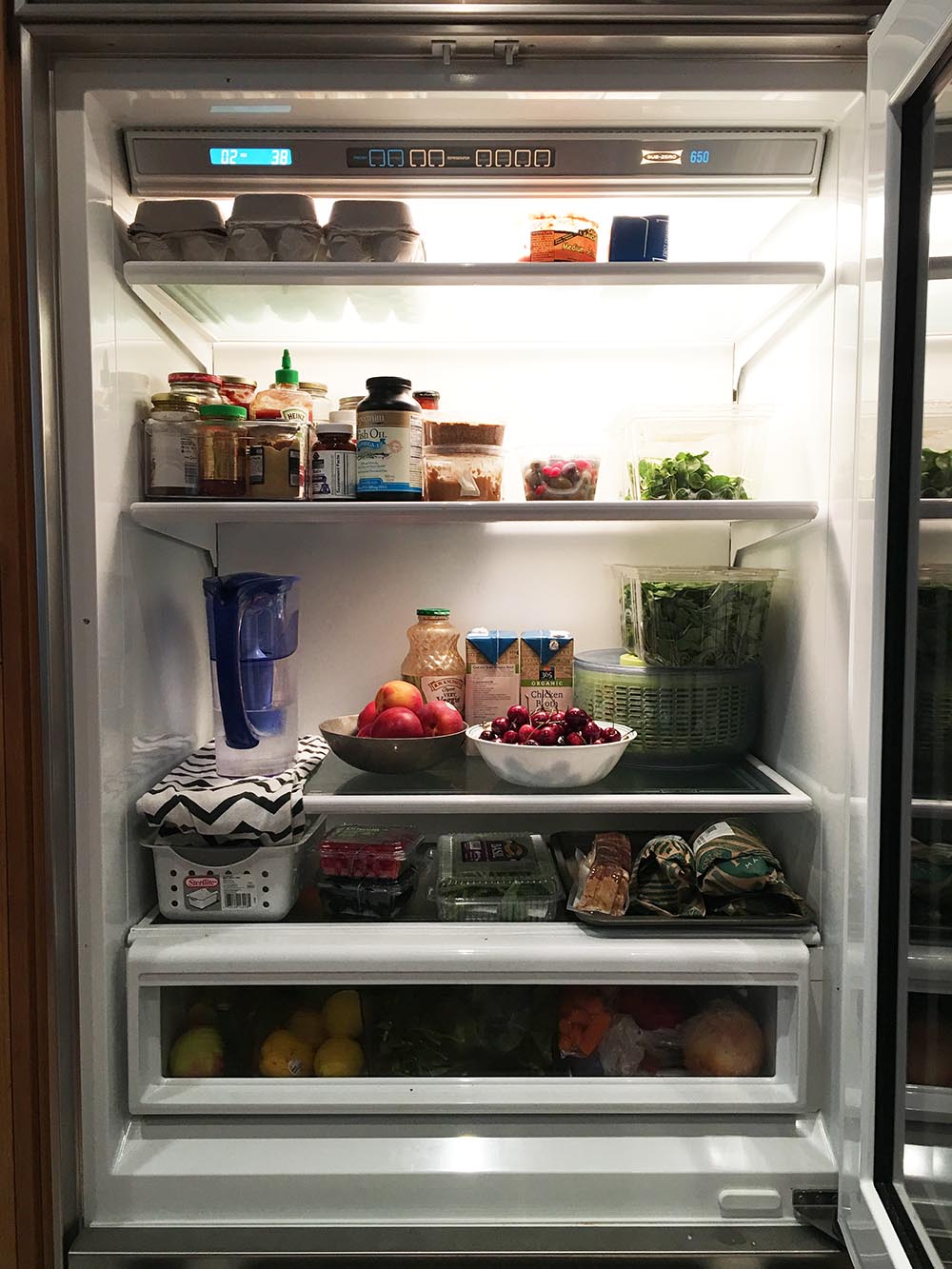
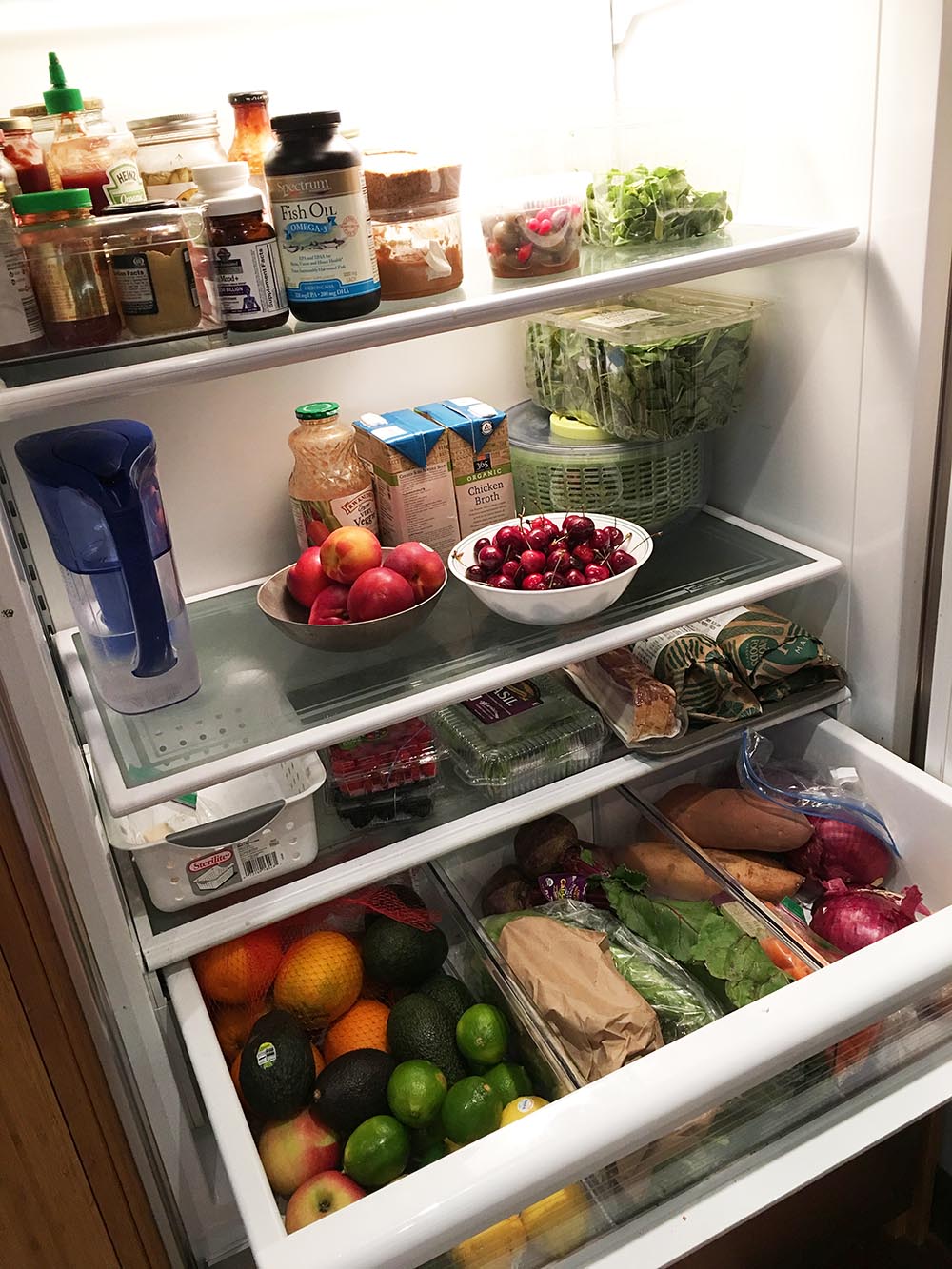
Yes, that is a fully stocked fridge for us. Joe and I eat pretty healthfully at home — I’ve recently been doing a modified version of the Whole30 diet just to assist my immune system and reduce inflammation, and honestly, it wasn’t really a big deal or change for us. Part of this is because we already eat a lot of whole foods in every meal, and part of this was because of my culinary background. You tell me to make clarified butter, or to do something with 2 pounds of zucchini, and I can come up with something on the fly without a lot of thought or any need for a recipe.
Our fridge is normally full of fresh organic fruit (I like snacking on it or eating it for dessert), a mixture of greens, veggies, organic meats, and lots and lots of condiments (we are mustard and hot sauce fiends). We don’t drink any soda or milk of any variety — cow, almond, soy, or otherwise (Joe and I both hate the texture of liquid milk, BARF). “Bad” things in our fridge and pantry include the occasional pint of ice cream, chocolate chips (I like eating a handful for dessert every now and again, though after cutting out sugar, I recently ate a few and it made me nuts), and boxes of pasta for those days when you need a carb fest.
We are not strictly gluten or dairy free, though we try to limit both.
Talking about diets is like talking about religion and politics.
//
Q: What was your experience like in culinary school?
A: A rollicking, frustrating, rewarding, draining, eye-opening adventure that I’m immensely glad I did and would also never do again.
This fall, it will have been TEN YEARS since I started culinary school, which blows my mind! Here was my average day as a culinary student: I would get up at around 5 or 5:30 in the morning, wash my face, brush my teeth, put on most of my school uniform (the ugliest, yet comfiest black and white checkered pants you can imagine, a sports bra and t-shirt of some kind, and — gasp! — kitchen-approved Crocs), pack up the rest of my uniform (a cravat, a cotton skull cap, multiple side towels (they’re like small kitchen towels), an apron, and my chef’s coat), my knife roll (it’s like a portable knife kit that held common tools you’d need), and a backpack filled with books and notebooks. I’d walk to the MUNI station, then take the train or bus to school. I always aimed to get in to school by 6:30 at the absolute latest; class started at 7, but you needed time to set up your station, and often, the extra time was helpful to get items together to prep for class, or get a head start on an assignment if you needed the extra cooking time. Class ran from 7 to noon; after this, you’d finish cleaning up, and sometimes we’d stick around to eat or talk to the instructor. Around four days per week, I was working afternoons and evenings at a local Sur La Table store, so I’d hustle home, shower, eat if I hadn’t already done so at school, then walk over to the Ferry Building. My shift usually started at either 2 or 3, and then I’d work until 8:30 or 9:30 pm. I’d be home by 9 or 10, eat a snack, sometimes watch a little TV, then pass out and do the whole thing over again. Looking back, I have no idea how I did it, because it was really, really tiring. I remember my legs being very toned, since I was on my feet and walking around all day, everyday.
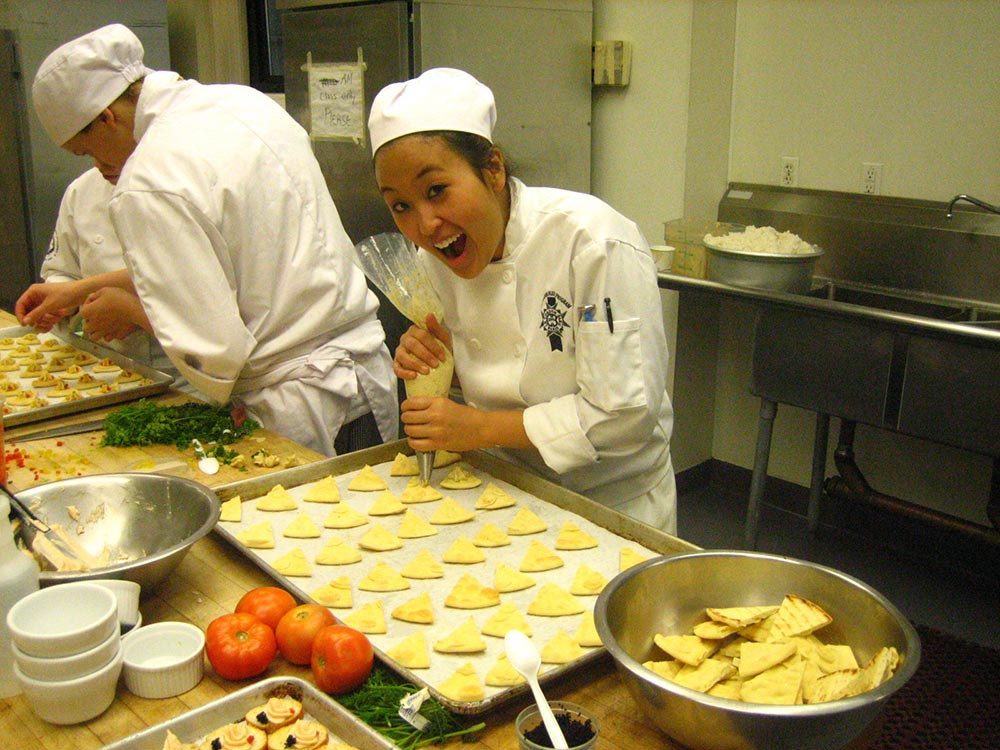
Piping for canapés in our first garde manger class
School itself was structured in various thematic blocks. Your first six weeks, you’re in a basic skills class, learning knife cuts and the foundations of French cuisine. Throughout the program, there were classes on contemporary cuisine (think special diets), American cuisine (from creole to southwestern to Californian), and Asian cuisine (that kitchen had these huge wok stations, which taught me that you can never replicate a restaurant quality stir-fry at home). We also did two series of classes in baking/pastry (we made cakes, pastries, all kinds of candies, and even learned how to work with decorative sugar), garde manger (think little appetizers, canapes, terrines, all that kind of stuff), and in wine (probably my favorite!). I went into culinary school a decent cook, but came out of it a lot better. You can put basically any set of ingredients in front of me and I can make you something, without a recipe. The joke in our household is that I can MacGyver anything together, just by looking in the fridge and pantry and seeing what we have.
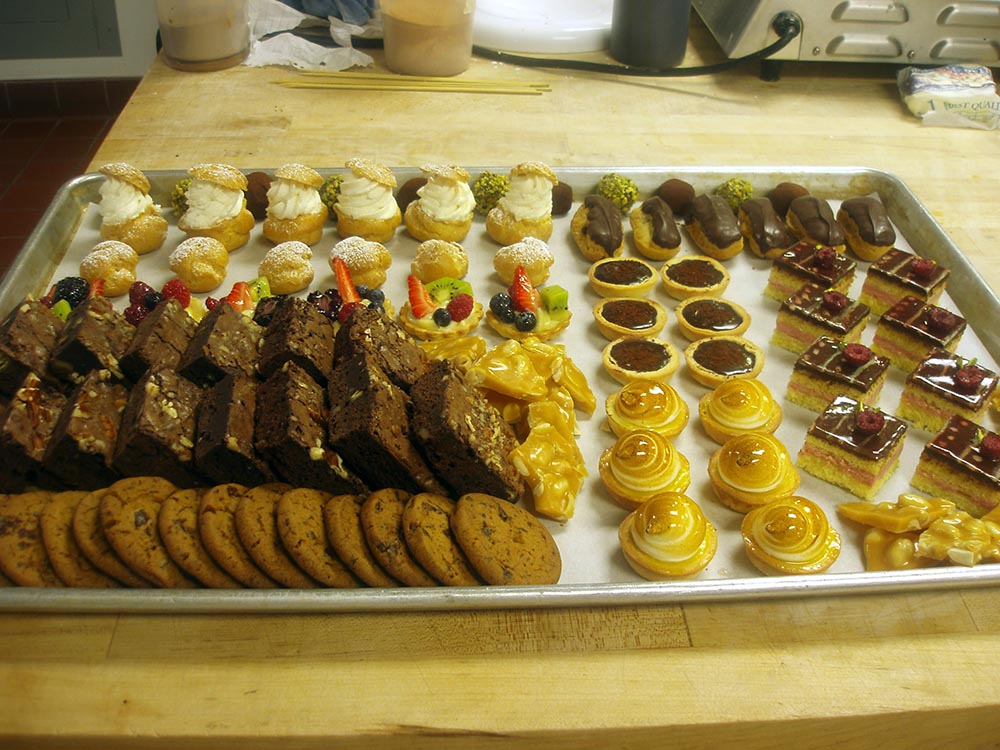
My ‘comp’ (like a final exam) for the first of two baking & pastry courses.
Culinary school was frustrating at times, especially coming from a four-year university. I started culinary the fall after I’d graduated from USC, and with a technical program, the approach and standards academically were just really different. The school I attended had also recently converted to a for-profit model a few years before I started, which I think is detrimental to any educational system. The mix of students was really diverse, in both wonderful and not so wonderful ways. I met so many cool people who I wouldn’t have otherwise known; on the flip side, there were often a lot of very young kids in the program that didn’t know what they wanted to do with their lives, so their parents had enrolled them as sort of a last resort. You’d get people that were highly motivated and excited to learn, and others that could care less and were turning out product that was inedible and sad, to put it mildly. There were shitty some days, when your team members didn’t want to work together, or didn’t care about food waste, or frankly, didn’t care about their own futures. In some really awful cases, a couple instructors weren’t engaged with students and weren’t truly there to help teach them and become better cooks, and those were the worst classes of all. But on the flip side, there were absolutely fabulous instructors who taught me things about cooking and food and art that I still think about all the time.
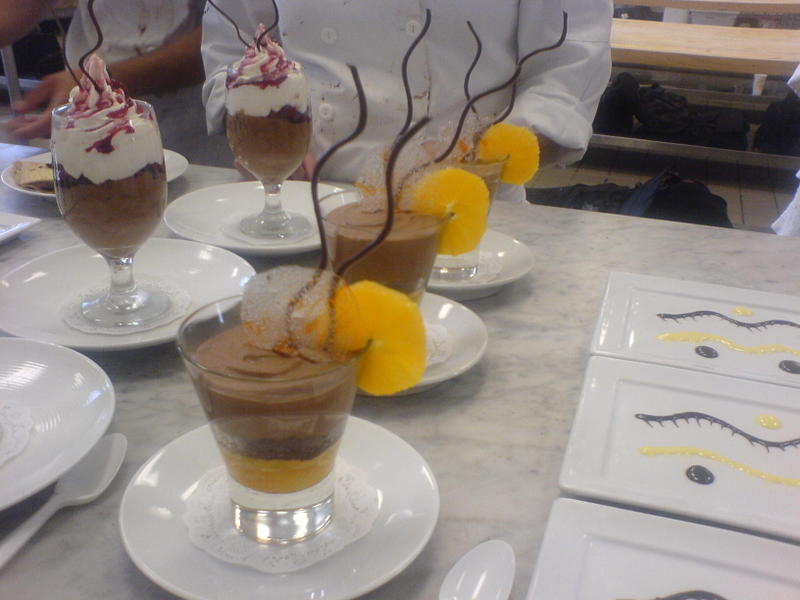
My comp for our second baking and pastry course. I think it was macerated or brandied orange, with chocolate sponge cake, chocolate mousse, and some type of “stained glass” sugar garnish.
I don’t regret going to culinary school at all. I was in a funny phase in my life, where I was beginning to suspect I didn’t want to embark on a traditional career path, but I wasn’t sure how or where to direct my passions and creative energy. Ultimately though, culinary school led to an internship with the San Francisco Chronicle, which led me to freelancing for them, which led me to my first taste of being a small business owner via a (very fledgling) freelance writing career. Writing for the Chronicle is also what prompted me to start a food blog — you might know it as vmac+cheese, which still exists today via the blog you’re reading right this second. The blog eventually became a lifestyle blog, which is how I met a lot of you, which is what led me to web design, which is what I think I was meant to do all along. It’s funny how life works out.
And for the record: I still own one pair of those ugly checkered chefs pants, and wear them when I’m sick. They’re just so comfortable, you guys! But never fear, the Crocs are longgggggg gone.
Questions on NY and SF
Q: Long-time reader now looking into moving to SF from NYC for 5 years (lived in LA before). While I like NYC, I wonder if your readers might be interested in a follow up on moving back to SF and what the experience is like. A lot of online commentary make SF seem too expensive, hard to get an apartment, with bad public transit etc., and it would be cool to get your perspective.
A: I don’t care what anybody says or what price indices show — in my own personal experience, New York City is still more expensive than San Francisco. Granted, San Francisco has gotten a lot more expensive now than it was 5 or so years ago, but I think it’s still less than NY, overall. We paid more in rent there for far less space; more for shittier quality produce; more in transportation costs; more on dinners out; more on pretty much everything.
I think that’s the general theme of my response to your question: yes, SF is all those things you mentioned, but to me, NY is worse (with the sole exception of public transit — I have a car in SF, which I didn’t in NY, so I either drive everywhere or Uber. In NY, I’d Uber, cab, and subway, and public transit is undeniably better there). Is it hard to get a great apartment at a great price in a great neighborhood in SF? Sure. But knowing how broker fees work in NY, and the amount of space you’re going to get at the same price point, I think you’ll find it less of a nightmare.
One thing I have noticed is that many people who’ve been living in NY for a long time and move to SF don’t always like it. This isn’t universally true (and in fact, is often untrue for people who are in their 30s who want to raise a family, at least in the very small sample size I’ve polled), but it’s a common trend. I think the cities are very different, and if you “grow up” in a place in your early 20s, you sorta get used to the culture and the people. If you like that culture and those people, sometimes the culture shock doesn’t ever quite wear off. When I first moved back, I met someone who had also just decamped from NY, and not realizing I’d lived in SF before, she said something like “All anyone here does is hike and go to the parks and beach,” which I found hilarious because a) what’s so bad about those things? and b) those were the things I missed most when I lived in NY.
Increasingly though, people talk about the New York-ification of San Francisco, as recent tech money has made its presence known throughout the city, and downtown (and outlying neighborhoods) continue to gentrify and develop. Below, I talk about how my current apartment is across the street from my old one; well, what’s also interesting is how much my neighborhood transformed in a mere 2 years. A few years ago, it was still pretty quiet in terms of restaurants and retail, and now there are trendy choices everywhere. I can definitively say that SF is more similar to NY now than it was when I first left it in early 2013, but I prefer it to living in Manhattan, any day. I mean, Napa is like an hour away — what’s not to love?
//
Q: What do you miss most (if anything??) about NYC?
A: I miss my friends, of course. When I lived in New York, I’d met most of my friends through the blog or online world, so I had the unique experience of having a ready set of “work” friends, who also happened to have the exact same interests and passions as me. I don’t have nearly as many friends in SF that work in the tech/digital media space and/or are entrepreneurs, so there aren’t as many people to talk shop with. I also think the way NY friends talked about their lives and their work was different than many of my SF friends, and I miss some of those dynamics.
On some days, I miss the energy and the sense that anything was possible. But I also remember the exhaustion and pervasive competition that permeated all parts of life there, which quickly snuffs that longing out! I’ve come to the conclusion that a lot of living in New York in your 20s and 30s is a feeling. I sometimes miss that feeling of walking down the street on my way to or from dinner and thinking to myself, “Ah! I can’t believe I live in New York City!” For us though, once we were over the self-congratulations, life there was pretty inconvenient and stressful. Joe and I talk a lot about ways in which we could’ve made it work, and we always conclude that our lives would’ve had to be completely different. I’m ok with how things worked out.
The Random Personal Questions
Q: What’s your favorite travel destination?
A: Let’s view this question through the lens of trips I like to take. For me, there are two types of trips: adventure/discovery trips, and lounge/do nothing trips. With an adventure trip, I personally hate packing in too many destinations, and instead prefer to park it in one spot for several days (or more), so I can get to know a place and really experience it. Maybe that’s because I like a fair bit of lounging mixed in with the discovery.
I have three favorite adventure trips that come to mind. When I was about 12 or 13 years old, my family spent a week at a dude ranch in Colorado. I had learned how to ride horses growing up, but on this trip, you rode all day, everyday, into the forests in the Rockies. The ranch even hosted a rodeo that I rode in! So I credit that trip with learning how to really ride (and run) a horse. I haven’t ridden since I was in college, but I keep trying to convince Joe to go with me up in Marin.
Another great adventure trip was the 3 week trip my family took to Alaska when I was about 14. We flew into Fairbanks, then took a two week road trip south throughout the state, leaving us in Seward. We rode horses (of course), hiked over glaciers, and took a 12-hour bus tour in Denali that was rather…well, long. And bumpy. From Seward, we took a boat down to Vancouver. That was a cool trip, though at the time, I’m pretty sure I complained a lot and sat in the back of the rental car listening to my Discman and pretending I didn’t care. Kids!
Most recently, I absolutely adored the trip Joe and I took to the south of France in 2012. I would go again in a heartbeat. You can read more about it here.
Paris is probably my favorite place to visit; I would go multiple times per year if I could.
Now, for lounging trips, you can pretty much fly me to the nearest tropical locale, and I’m happy. When I was growing up in Texas, the Caribbean was conveniently close; here in California, trips to Mexico are always lovely. Lounge trips are for when we need to reset, sit by a pool or the beach with a drink, and catch up on all those books we’ve been needing to read. On those types of trips, I usually won’t even leave the resort we’re staying at, and I go home not feeling bad about it one bit.
//
Q: Did you ever go through a terrible breakup? If yes, any words of advice that you may have?
A: To be honest, I haven’t. The only breakup that could even come close to being described as “terrible” would be my boyfriend that I dated on and off for 3 years in high school. When it was ending during my first year of college (I say ending vs. ended since we both kept waffling on how it was all going to work out), I guess that was terrible, but in the sense that I was in that weird phase of transitioning into this new life away from home, not wanting to hurt this person’s feelings, and also being 18 years old and not really knowing what I wanted or needed anyway. Looking back, that breakup feels very normal and understandable, and doesn’t feel so terrible. I met Joe my freshman year of college and we started dating in the fall, and have been together since then, really.
I’m not sure I know what advice to offer that won’t feel trite and ignorant, so if you’re going through a hard time now, all I can say is give yourself permission to feel grief, anger, resentment, embarrassment, etc., think about what lessons you want to take from that relationship into your future, and remember that you are enough!
Also, I made you a breakup playlist.
//
Q: I’m curious what other cream blushes you’ve been using lately. I’ve been on the search for awhile and am hoping you have some winners you can share.
A: I got this question on last week’s beach-inspired post, and figured I’d throw it in here! I’ve been using W3LL People’s Universalist Multi-Stick 8 in Dusty Rose all summer, and really love it. It’s highly blendable, non-toxic, has been nourishing for the skin. You can buy it directly from their site, and Beauty.com stocks it too! I also really like Wander Beauty’s On-The-Glow stick, which includes a cream blush and an illuminator (the Coral Glow color was lovely on my skin!), though their products are not in the natural beauty category. If you come across it, I really did love Herbivore’s Lip Tint mentioned here. Though it’s marketed as a lip tint, I suspect it’d be great as a creamy cheek stain too. I’m also still working my way through RMS’s Lip2Cheek in Promise, though I tend to use this more as lip color than cheek color.
//
Q: When are you guys having kids?
A: In two years? Five? Never? I honestly have no idea. Deciding to become a parent — and then the journey that ensues, whatever it looks like — is so highly personal and individual. For us, starting a family is not currently a priority, but perhaps that’ll change in the next few years. Or not. Who knows? If I’m honest, I sometimes feel really panicked about the idea of raising a child, as rewarding as I know it would be. I’ve always said I’m in the 0-1 category, in terms of how many I’d want. Maybe this is because I was an only child? Small families feel really normal to me.
//
Q: What time do you wake up in the morning/go to bed at night?
A: This really varies from season to season, as how I’m feeling, work loads, and even Daylight Savings Time all really impact my schedule. I find that in the fall and winter, I tend to wake up on the earlier side, like 7am or earlier. In the spring and summer, even though it gets lighter earlier, I tend to sleep later. No idea why this is, since it seems like the reverse would make sense, right? At night, I typically go to bed between 10:30 and midnight, it just depends if I get caught up watching a show, or doing my reading. I read a LOT before bed and when I wake up in the mornings. Mostly articles online — I have a minor obsession with keeping up with pop culture, current events, culture news, all that stuff. I wrote a little more about that here.
//
Q: I’d love to know all about Lucy. I haven’t been reading long enough to know if she joined your family as a puppy, but I’d love to hear about training, life in the city with a dog, what you did to prepare for a dog, etc. I’m bringing home a new puppy in 2 weeks, so it’s all I can think about lately.
A: Lucy joined our family when she was 4 months old. Here are some of the first pictures we got of her:



Gah, she was the cutest puppy!
I was kind of a nut about training and learning everything I could about canine behavior, so that I could learn to speak her language and she could learn to speak ours. It was very helpful that I was working from home, and could spend a lot of time with her, train her, teach her what was acceptable in our house, all that.
Let’s see, to prepare for her, we took many trips to local pet stores and picked up bedding, toys, all that kind of stuff. Looking back, I’d say don’t go too nuts at first, because we bought a lot of things that she didn’t really like or ever use; it would make more sense now to test different types of toys and beds to see what she took to. For example, she’s not really into playing fetch with a ball, nor does she enjoy chewing on rope toys, so though we bought both types of toys, they went unused (we donated them to another puppy friend!).
One way we prepared for her was to have a lot of conversations about being a team. We knew it was going to be a huge pain in the ass to teach her to go to the bathroom outside, partially because at the time, we lived in a condo building with elevators and no outdoor space. So any time she needed to go out, we’d have to harness her up, take her down an elevator (which, having grown up on a farm in the countryside, she was terrified of for at least a month), then walk a couple blocks to the nearest grassy area (because, as we learned, home girl hates going to the bathroom on cement — some dogs do, FYI). We’d go through this whole song and dance at least once per night, meaning our sleep schedules were interrupted. We planned out a schedule for who would take her out when, and tried to be patient with each other in those early weeks while we all adjusted to life together. It’s a huge change! The first couple of months, I think we both thought we’d made a huge mistake, simply because bringing a dog into your family dynamic completely changes your lifestyle. I can’t emphasize that part enough! But, I remember the moment I fell in love with Lucy (it was about a week after she’d come home), and once we found our rhythm, it was all good. I can’t imagine my life without her anymore; she’s really like my daughter, and the light of our life.
Oh, for training. We had a trainer come over to our house for two individual sessions, to show us how to work with her, get some tips, talk about behaviors we wanted to eliminate, all that. From there, I did most of the work with her. When we’d had her for a few months, we took her to a formal 4-week class, and she was the superstar student who already knew how to do everything. Even though investing in the at-home training sessions was more expensive than taking a class, I think the one-on-one time gave us so many tools and allowed the trainer to really assess Lucy and give us the most customized advice. We are extremely lucky that she is an extraordinarily bright dog, a lovebug, and highly trainable. We even taught her the difference between speaking and whispering! #ProudMama
A few books I read that you might find helpful: It’s Me or the Dog (highly recommend this one); Canine Body Language (not as practical, but a useful resource when we were trying to decipher whether she was anxious about something); and French Bulldog Breedlover’s Guide (Frenchie specific, obviously, but this company publishes breed-specific books, and ours was very informative).
//
Q: Do you see yourself in SF for the long haul? How did you find your current place in such a cutthroat real estate market? I am always interested in hearing more about people’s real estate decisions/learning more about their homes/learning more about their neighborhoods.
A: Yes, I think we’ll be in SF for the long haul. The only other places I could see us moving would be LA and NY. Does that surprise you? Ugh, it surprises me too, and I would probably go kicking and screaming a little bit, but given Joe’s industry, you just never know what’ll happen down the line. But, assuming things went according to plan, both of us talk about our family life together as if we’re staying here in the Bay Area!
Ok, don’t hate me, but we found our current place very easily, while we were still living in NYC. We knew we were moving back to SF, and Joe happened to be looking on Craigslist one afternoon. He came across a new listing for an apartment that was right across the street from our old one, which made it convenient since we knew the neighborhood (and, the building) very well. We got our application in that same day, before there was ever an open house. Due to a contractual issue, we had to have friends go view the apartment the next weekend during the official open house, but once they did so (and FaceTimed us while they were there), we got the place since our application was the first in. It was really just a matter of being in the right place at the right time. But if you can believe it, we signed a lease on our apartment essentially sight unseen! No regrets though — I love our current apartment and really don’t want to move.
In New York, finding an apartment was a complete nightmare (I wrote about it here). I don’t think you could pay me to go through that experience again. Our previous apartment searches in SF were a mixed bag. A couple were simple — these were the ones in which we were moving into a larger, corporate building, so the leasing process was really straightforward. We had to do a bit of hunting to find our apartment out in the Inner Richmond, but compared to NY, it wasn’t so bad (a few open houses, coming prepared with references, money to put down on a deposit, all that stuff).
//
Whew! That was a lot. I hope you guys enjoyed reading through all these answers and maybe learning something new about me! Thanks so much for sending in your questions and being part of my little community here!
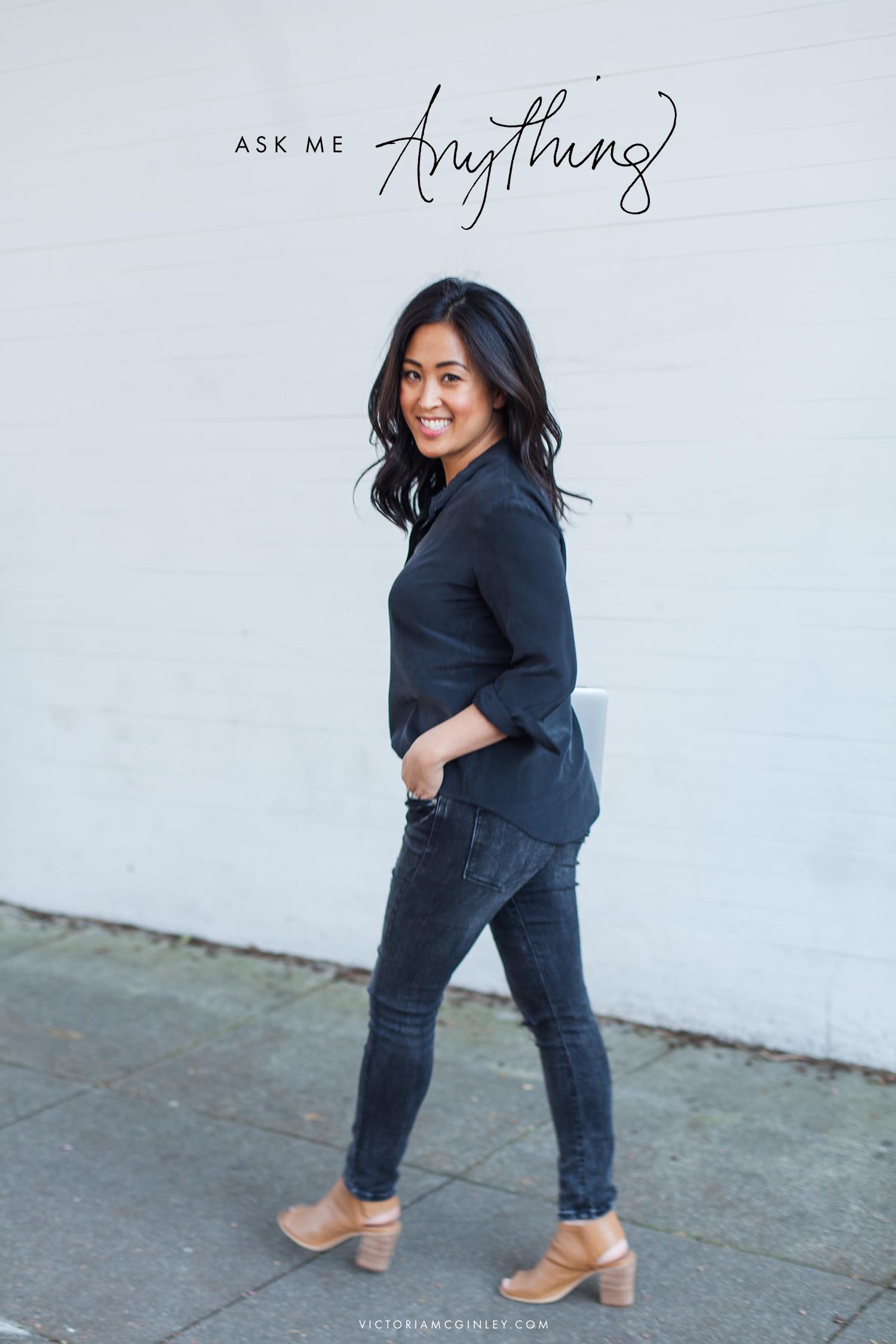






Thank you so much for your answer and for taking the time to make a playlist, it’s so kind of you. I really appreciate it!
You’re very welcome — hope you enjoy! And hang in there.
hi victoria, i’m a long-time follower of your blog, but don’t think i’ve ever commented. wanted you to know how much i enjoyed this post. thanks for your honest answers. i especially liked the responses on living in nyc vs sf.
Thank you so much, Catherine! :)
I loved this!!! Still read your blog all the time, V! xoxox
This was so great to learn more about you! Thank you for sharing :)
Hi. I asked for advice last year and you replied. Super helpful. New question: I get inspired attending conferences about social media/motivation/leadership. I plan on attending the alt summit next year. My challenge is learning about conferences BEFORE they occur. How does when get in the know?
Hi Mimi! This is kinda tough since you obviously don’t know what you know. Two things I’d suggest: 1) Get Googling. If you search for something like “list of blog conferences,” there are a ton of results that will come up. It can take some time to comb through, but check out all the different directories and bookmark conferences you’re interested in. You can add reminders to a calendar or wherever you keep track of such things to sign up for more info, register, etc. 2) If you see a conference you missed, make a note about it on your calendar. It’s possible that another 6 months or so, registration will open for the next year, and you’ll already have it on your radar!
For any conference you come across that sounds interesting, definitely follow them on Instagram and Facebook, and sign up for a newsletter if they’re offering it. Those are easy ways to all but guarantee you won’t miss important announcements about registration, speakers, all that jazz. Hope that helps!
Hi V. What blogs do you follow religiously? You have impeccable taste.